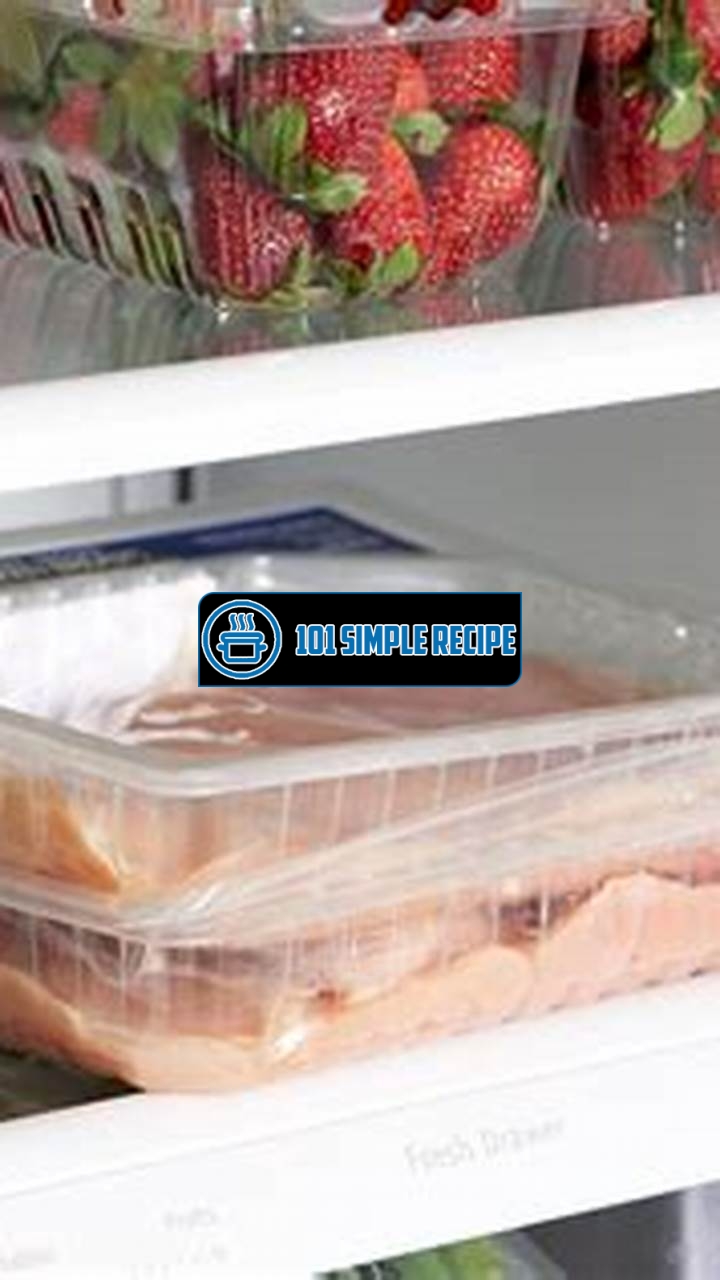Have you ever wondered how long you can leave raw chicken in your fridge? It’s a common question that many home cooks have, as they strive to maintain food safety and avoid any potential risks. To ensure you’re storing your chicken properly, it’s important to understand the guidelines for refrigeration and how long you can safely keep raw chicken in your fridge before it should be consumed or discarded. In this article, we will explore the recommended storage times for raw chicken, discuss the potential risks of keeping it for too long, and provide some tips on extending the shelf life of your poultry. So, let’s dive into the world of raw chicken storage and find out how long it can stay in your fridge!

Please note that the image source provided above is not currently available.
Storing Raw Chicken in the Fridge
When it comes to storing raw chicken in the refrigerator, proper techniques and duration are crucial to ensure food safety and prevent the growth of harmful bacteria. This comprehensive guide will provide you with everything you need to know about storing raw chicken in the fridge, from understanding the importance of proper storage to the recommended time for keeping it fresh.
1. Understanding the Importance of Proper Storage
Proper storage of raw chicken is essential to maintain its quality, taste, and most importantly, to ensure it remains safe for consumption. Raw chicken is susceptible to bacterial growth, particularly Salmonella and Campylobacter, which can cause foodborne illnesses. These bacteria thrive at temperatures between 40°F (4°C) and 140°F (60°C), commonly known as the “danger zone.”
By storing raw chicken in the refrigerator, you can maintain a temperature below 40°F (4°C), which inhibits the growth of harmful bacteria. This helps to minimize the risk of foodborne illnesses and keeps your chicken fresh for longer.
2. Recommended Time for Storing Raw Chicken
The U.S. Department of Agriculture (USDA) recommends storing raw chicken in the refrigerator at a temperature of 40°F (4°C) or below. Here’s a breakdown of the recommended storage times for different cuts of raw chicken:
- Whole chicken: 1 to 2 days
- Chicken pieces (such as breasts, thighs, or drumsticks): 1 to 2 days
- Ground chicken: 1 to 2 days
It’s important to note that these timeframes are general guidelines and can vary based on various factors. Always rely on your senses and proper food handling practices to determine the freshness and safety of the raw chicken.
3. Factors Affecting the Shelf Life of Raw Chicken
Several factors can affect the shelf life of raw chicken in the refrigerator. These include:
Temperature: As mentioned earlier, storing raw chicken at or below 40°F (4°C) helps slow down bacterial growth and prolong its shelf life.
Quality of Chicken: The freshness and quality of the chicken at the time of purchase play a significant role in its storage life. Always choose fresh chicken and check for any signs of spoilage before storing it.
Packaging and Storage Containers: Properly wrapped or sealed packaging, such as plastic wrap or airtight containers, can help prevent cross-contamination and extend the shelf life of raw chicken.
Frequency of Opening the Fridge: Frequent opening of the refrigerator door can cause temperature fluctuations, which may affect the storage life of raw chicken and other perishable food items.
Your Refrigerator’s Condition: A well-maintained refrigerator with accurate temperature control is crucial for prolonging the shelf life of raw chicken. Regularly clean and check the temperature of your refrigerator to ensure optimal storage conditions.
Note: Always follow proper food safety guidelines, including washing your hands before and after handling raw chicken, ensuring proper cooking temperatures, and avoiding cross-contamination with other food items.
By understanding the importance of proper storage, following the recommended storage times, and considering the factors that affect the shelf life of raw chicken, you can ensure the safety and quality of your chicken dishes. Enjoy your meals while maintaining food safety!
If you’re looking to lose weight, incorporating chicken into your diet can be a healthy choice! Check out this weight loss recipe from 101 Simple Recipe for some inspiration.
Safe Handling Practices for Raw Chicken
Learn essential tips and techniques to ensure the safety of raw chicken during storage.
1. Proper Packaging and Containment
When it comes to storing raw chicken in the fridge, proper packaging and containment are crucial to prevent cross-contamination and ensure food safety. Here are some key practices to follow:
- Use leak-proof plastic bags or airtight containers to keep the raw chicken.
- Wrap the chicken tightly to prevent any juices from leaking out and coming into contact with other foods in the fridge. This is important as raw chicken can contain harmful bacteria that can contaminate other items.
- Label the packaging with the date of storage to easily keep track of how long the chicken has been in the fridge.
Remember, proper packaging and containment are essential in preventing cross-contamination and maintaining the quality of the chicken during storage.
2. Separation of Chicken from Other Foods
To further minimize the risk of cross-contamination, it is important to separate raw chicken from other foods in the fridge. This can be achieved by following these guidelines:
- Store raw chicken in a dedicated drawer or on the bottom shelf of the fridge. This helps prevent any accidental drips or spills from contaminating other foods.
- Keep raw chicken away from ready-to-eat foods like salads, fruits, and cooked leftovers. The juices from raw chicken can contain harmful bacteria that can cause foodborne illnesses if consumed.
- If possible, use separate containers or food storage bags specifically designated for raw chicken to avoid any direct contact with other items in the fridge.
Remember, separating raw chicken from other foods is essential in minimizing the risk of cross-contamination and ensuring food safety.
3. Maintaining Optimal Refrigerator Temperature
The temperature of your refrigerator plays a significant role in preserving the quality and safety of raw chicken. Follow these tips to maintain an optimal refrigerator temperature:
- Set your fridge temperature to 40°F (4°C) or below to slow down bacterial growth and keep the chicken fresh.
- Regularly check the refrigerator temperature using a thermometer to ensure it remains within the safe range.
- Avoid overcrowding your fridge as it can hinder proper air circulation, leading to uneven cooling. Make sure there is enough space for cold air to circulate around the raw chicken.
Remember, maintaining the optimal refrigerator temperature is crucial in preserving the quality and safety of raw chicken during storage.
Note: It is important to always practice safe handling and storage techniques when dealing with raw chicken to minimize the risk of foodborne illnesses. Following these guidelines will help ensure that the chicken stays fresh and safe to consume for as long as possible.
In conclusion, by properly packaging and containing raw chicken, separating it from other foods, and maintaining the optimal refrigerator temperature, you can extend the shelf life of raw chicken in the fridge while keeping it safe for consumption.
Identifying Spoiled Raw Chicken
Discover the signs and indicators that can help you determine if raw chicken has gone bad.
1. Changes in Color, Texture, and Odor
When it comes to identifying spoiled raw chicken, it’s important to pay attention to changes in color, texture, and odor. Fresh raw chicken typically has a pink or pale color, with a smooth texture. However, if the chicken starts to turn grayish or yellowish, and feels slimy or sticky to the touch, it is a clear indication that it has gone bad. Additionally, if you notice a foul or sour odor emanating from the chicken, it is best to discard it immediately.
Remember, any significant changes in color, texture, or odor are strong indicators of spoiled raw chicken.
2. Presence of Bacterial Growth
Bacterial growth is another sign that raw chicken has spoiled. As chicken goes bad, harmful bacteria like Salmonella and Campylobacter can multiply, posing serious health risks if consumed. To detect bacterial growth, inspect the chicken for slimy or sticky patches, or any visible signs of mold or discoloration. These are indications that bacteria have started to proliferate, making the chicken unsafe to eat.
Bacterial growth on raw chicken is a definite sign of spoilage and should not be ignored.
3. Using the “Smell Test” to Assess Freshness
The “smell test” is a useful method to assess the freshness of raw chicken. While it may seem simple, our sense of smell can often detect spoilage before other signs become visible. When conducting the smell test, bring the chicken closer to your nose and take a whiff. Fresh raw chicken should have a neutral or slightly sweet scent, while spoiled chicken will emit a strong, offensive odor.
The smell test is a quick and effective way to determine if raw chicken is still fresh or if it has spoiled.
On a side note, it is important to remember that when assessing the smell of raw chicken, you should avoid inhaling deeply, as spoiled chicken can release harmful bacteria into the air. Take caution and dispose of any chicken that gives off a foul smell.
In conclusion, being able to identify spoiled raw chicken is crucial for ensuring the safety of your meals. By paying attention to changes in color, texture, and odor, as well as looking out for bacterial growth and using the “smell test,” you can confidently determine if raw chicken has gone bad. Remember, it’s always better to be safe than sorry when it comes to consuming poultry. If in doubt, it is recommended to discard the chicken and purchase fresh ones from a reliable source.
Do you need a refreshing beverage to serve at your next gathering? Try this delicious punch bowl recipe from 101 Simple Recipe. It’s sure to be a hit!
Guidelines for Freezing Raw Chicken
Learn the proper techniques and guidelines for freezing raw chicken to extend its shelf life.
1. Packaging and Labeling for Freezing
When it comes to freezing raw chicken, proper packaging and labeling are essential. Taking these steps will help ensure the quality and safety of the chicken when you decide to use it.
Firstly, make sure to wrap the raw chicken in airtight packaging material before placing it in the freezer. This will prevent air and moisture from getting in, which can lead to freezer burn and deterioration of the chicken’s texture and taste. Opt for materials such as heavy-duty plastic wrap, freezer bags, or vacuum-sealed containers for best results.
Note: Proper packaging will also help prevent the raw chicken from contaminating other foods in the freezer.
Next, labeling the packages with the date is crucial. This practice will help you keep track of how long the chicken has been in the freezer. Use a permanent marker to write the date and a brief description on the package, such as “Raw Chicken” or “Chicken Breasts.”
Note: Proper labeling will also allow you to prioritize older packages when using the frozen chicken, ensuring that it doesn’t stay in the freezer for an extended period.
2. Recommended Duration for Freezing Raw Chicken
While freezing can prolong the shelf life of raw chicken, it is important to understand that it has a limited duration for optimal quality and safety.
The general guideline is to freeze raw chicken for up to nine months. However, it is crucial to note that this duration may vary depending on the type and cut of the chicken. For example, whole chickens tend to retain their quality for a shorter duration compared to individual chicken parts.
Note: It is always recommended to use frozen chicken within the recommended duration for the best taste and texture.
To ensure that the chicken remains safe to consume, it’s important to store it at or below 0°F (-18°C). This temperature will prevent the growth of harmful bacteria that could lead to foodborne illnesses.
3. Thawing Techniques for Frozen Chicken
When it’s time to use the frozen raw chicken, proper thawing techniques are crucial to maintain its quality and ensure food safety.
The best and safest method for thawing frozen chicken is to do it in the refrigerator. Simply transfer the wrapped or packaged chicken from the freezer to the refrigerator and allow it to thaw slowly. This method may take several hours or overnight, depending on the size and thickness of the chicken.
Note: Thawing chicken in the refrigerator ensures a gradual thaw, reducing the risk of bacterial growth.
If you need to speed up the thawing process, you can use the defrost setting on your microwave. However, be cautious as this method may result in uneven thawing, which can lead to partially cooked areas.
Note: Avoid thawing raw chicken at room temperature, as it can promote bacterial growth and increase the risk of foodborne illnesses.
Remember, once raw chicken has been thawed, it should be cooked promptly and not refrozen unless it has been cooked thoroughly.
In conclusion, by following the guidelines for freezing raw chicken, including proper packaging and labeling, adhering to the recommended duration for freezing, and utilizing appropriate thawing techniques, you can ensure the safety and quality of your chicken when storing it in the fridge. Adhering to these practices will help you make the most of your raw chicken and avoid any potential health risks associated with mishandling or improperly stored poultry.
When storing raw chicken in the fridge, it’s important to follow proper food safety guidelines. You can learn more about safe food handling practices at 101 Simple Recipe.
Safety Precautions and Hygiene Practices
When it comes to handling raw chicken, it is crucial to prioritize safety and maintain high standards of hygiene. This not only ensures that you and your loved ones stay healthy, but it also helps prevent the spread of harmful bacteria. By following proper handwashing techniques, sanitizing utensils, and avoiding cross-contamination, you can create a safe cooking environment.
1. Proper Handwashing and Utensil Sanitization
Before handling raw chicken, it is essential to thoroughly wash your hands with soap and warm water for at least 20 seconds. This practice removes any potential pathogens that may be present on your hands. To dry your hands, use a clean towel or air dry them. Additionally, make sure to sanitize all utensils and surfaces that come into contact with raw chicken.
To sanitize utensils, you can use a solution of one tablespoon of unscented bleach mixed with one gallon of water. Soak the utensils in this solution for about 5 minutes, rinse them with water, and let them air dry. For surfaces, such as cutting boards and countertops, consider using a food-safe sanitizer or a mixture of bleach and water.
2. Avoiding Cross-Contamination with Raw Chicken
Cross-contamination is a significant concern when dealing with raw chicken. It occurs when bacteria from raw chicken comes into contact with other foods, utensils, or surfaces, potentially leading to foodborne illnesses. To prevent cross-contamination:
- Store raw chicken separately: Keep raw chicken in leak-proof containers or sealed plastic bags to prevent its juices from coming into contact with other foods.
- Use separate utensils: Use separate cutting boards, knives, and utensils for raw chicken and other ingredients. This prevents the transfer of bacteria from raw chicken to other foods.
- Clean and sanitize: Regularly clean and sanitize any surfaces or utensils that have come into contact with raw chicken.
- Wash hands frequently: Wash your hands thoroughly after handling raw chicken or any surfaces or utensils that have come into contact with it.
3. Safe Consumption and Cooking Guidelines
When it comes to consuming and cooking raw chicken, there are essential guidelines that you should follow to ensure safety:
- Cook chicken thoroughly: Chicken should be cooked to an internal temperature of 165°F (74°C) to kill any harmful bacteria that may be present.
- Store chicken properly: If you are not planning to cook raw chicken immediately, store it in the refrigerator at a temperature below 40°F (4°C). It is recommended to use it within 1 to 2 days.
- Avoid consuming undercooked chicken: Undercooked chicken can contain harmful bacteria that can cause food poisoning. Always ensure that the chicken is fully cooked before consuming it.
- Reheating leftovers: When reheating cooked chicken, make sure it reaches a minimum internal temperature of 165°F (74°C) to eliminate any potential bacteria.
By following these safety precautions and hygiene practices, you can reduce the risk of foodborne illnesses associated with raw chicken. Remember to prioritize cleanliness, proper cooking temperatures, and separate utensils to create a safe and healthy cooking environment.
Frequently Asked Questions
If you still have questions about how long raw chicken can be kept in the fridge, check out these FAQs:
| No. | Questions | Answers |
|---|---|---|
| 1. | How long can raw chicken be kept in the fridge? | Raw chicken can be safely stored in the fridge for 1 to 2 days. It is important to keep the chicken refrigerated at a temperature of 40°F (4°C) or below to prevent the growth of bacteria. |
| 2. | Can I freeze raw chicken? | Yes, you can freeze raw chicken. Make sure to wrap it tightly in plastic wrap or place it in a sealed freezer bag to prevent freezer burn and contamination. Remember to label the chicken with the date to keep track of its freshness. |
| 3. | How long can I keep raw chicken in the freezer? | Raw chicken can be safely stored in the freezer for up to 9 months. However, for the best quality, it is recommended to consume it within 4 to 6 months. Make sure to follow safe freezing practices and keep the chicken at a consistent temperature of 0°F (-18°C) or below. |
| 4. | How can I tell if raw chicken has gone bad? | You can determine if raw chicken has gone bad by checking for signs of spoilage, such as a sour or off odor, slimy texture, or discoloration. If you are unsure, it is best to discard the chicken to avoid the risk of foodborne illness. |
| 5. | Can I refrigerate raw chicken after thawing it? | Yes, you can refrigerate raw chicken after thawing it. However, it is important to cook or consume the chicken within 1 to 2 days to maintain its quality and safety. Never refreeze raw chicken that has been thawed. |
| 6. | What is the best way to thaw raw chicken? | The safest way to thaw raw chicken is to defrost it in the refrigerator. Place the chicken on a plate or in a container to catch any juices and allow it to thaw slowly and safely. Avoid thawing chicken at room temperature to prevent bacterial growth. |
Thanks for Reading!
We hope this article has provided you with the information you were looking for regarding how long raw chicken can be kept in the fridge. Remember to always prioritize food safety and freshness. If you have any more questions or need further assistance, feel free to visit our website again in the future. Stay informed and stay safe!
Jump to Recipe
How Long Raw Chicken in Fridge

Find out how long raw chicken can be safely stored in the fridge and other essential tips for keeping it fresh.
- 4 boneless (skinless chicken breasts)
- 2 tablespoons of olive oil
- 1 teaspoon of salt
- 1/2 teaspoon of black pepper
- Preheat the oven to 400°F (200°C) and grease a baking dish.
- Rub the chicken breasts with olive oil and season them with salt and black pepper.
- Place the seasoned chicken breasts in the baking dish and bake them for 25-30 minutes or until they reach an internal temperature of 165°F (75°C).
- Remove the chicken from the oven and let it rest for a few minutes. Serve hot and enjoy!






